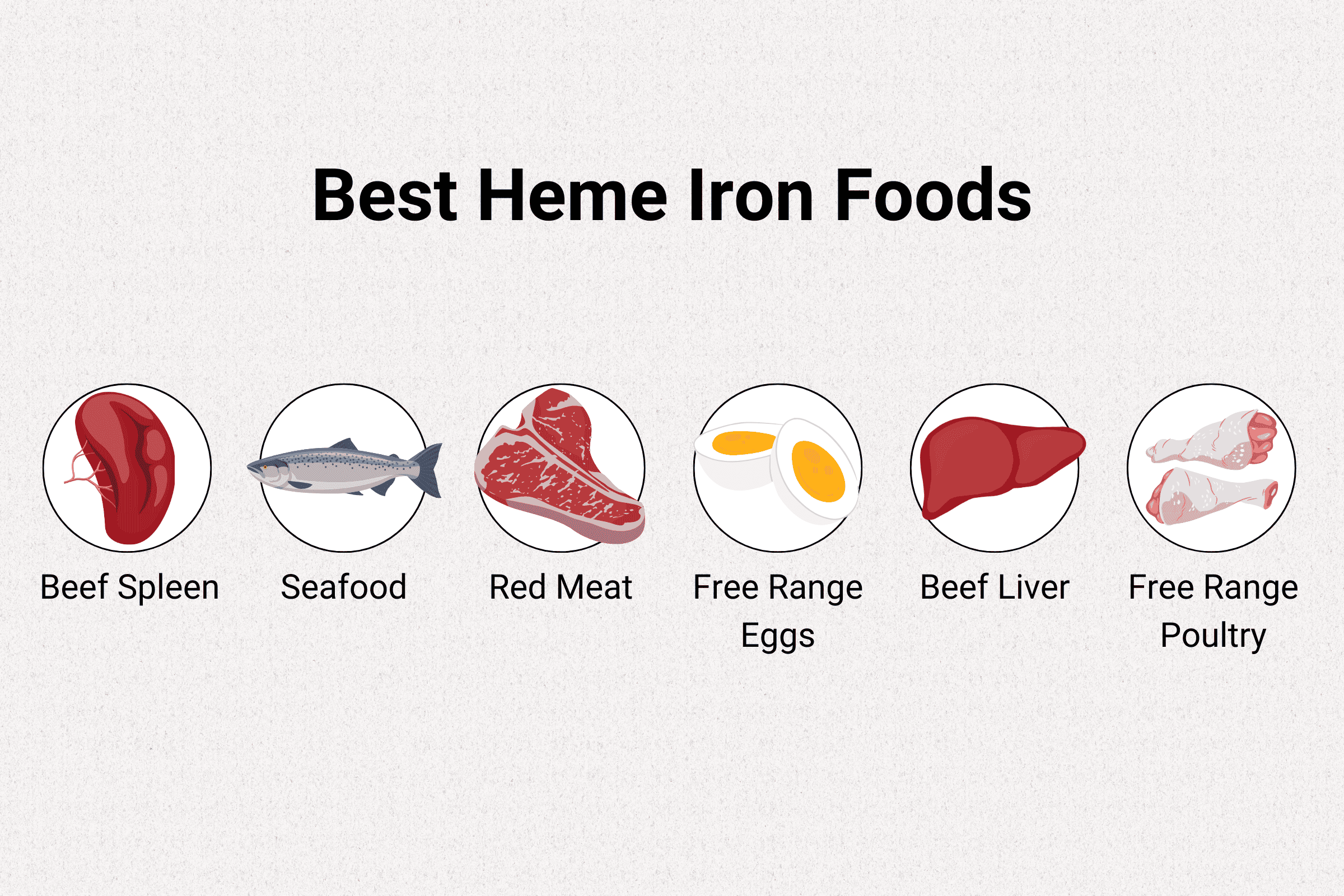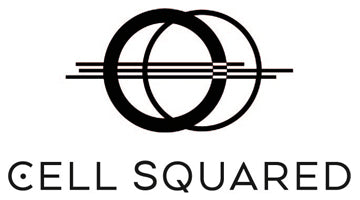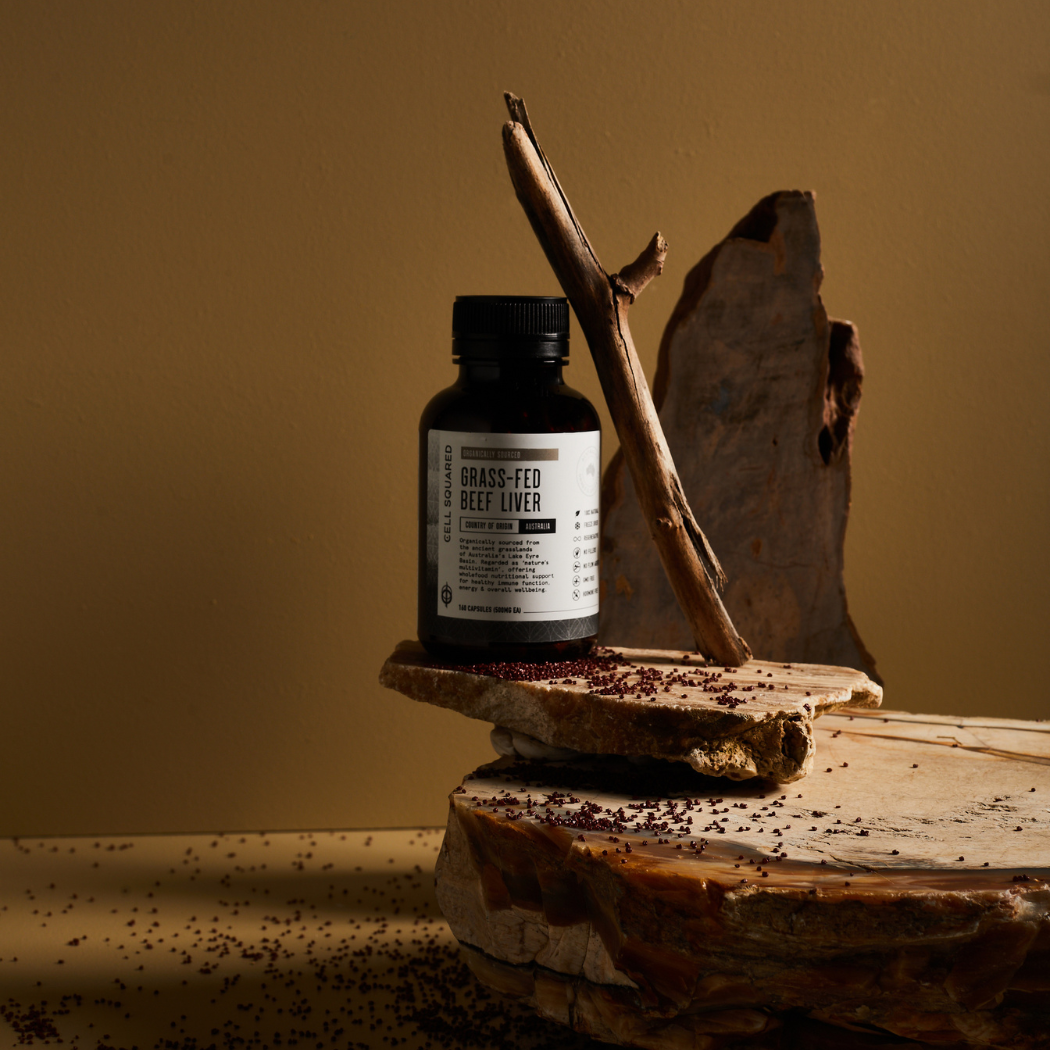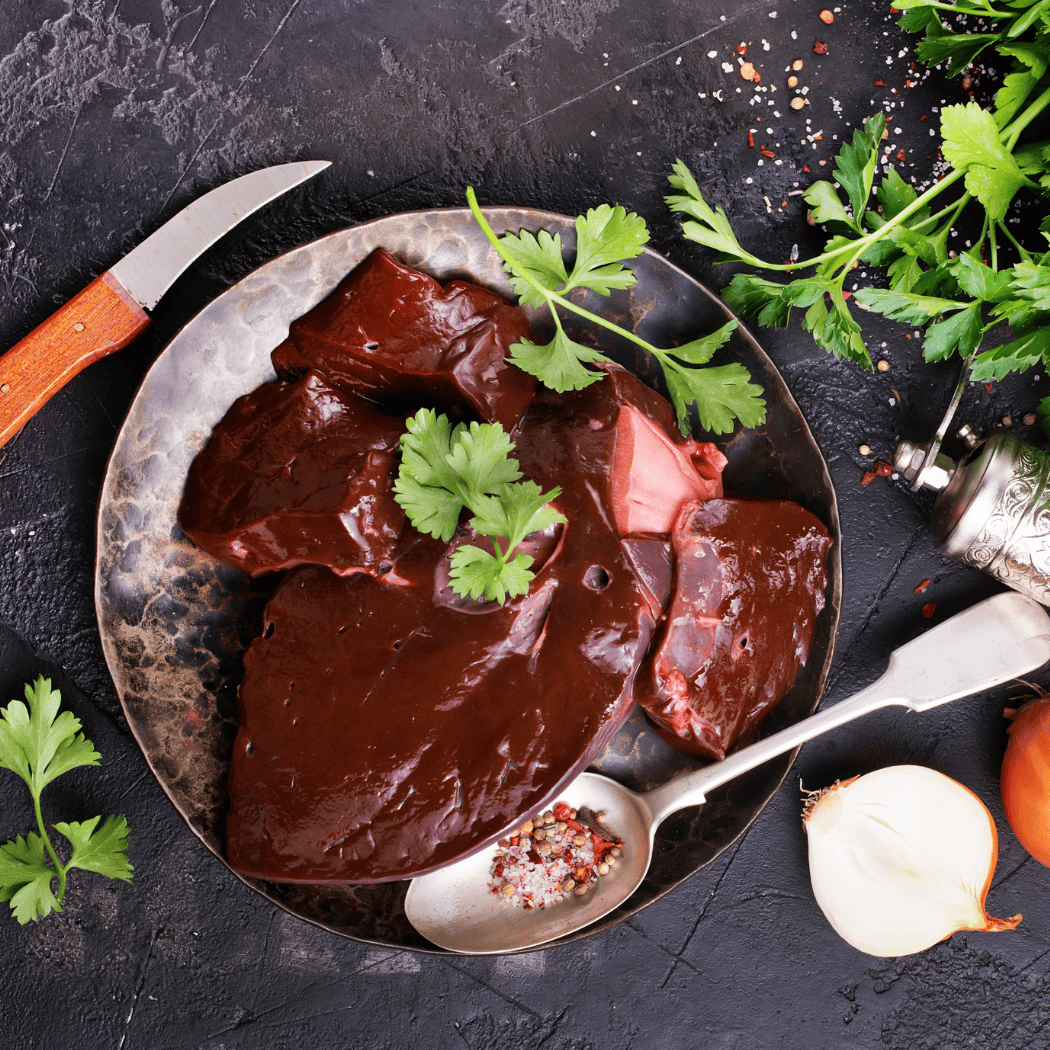Iron is considered an essential mineral & is found in EVERY cell of the body! Heme Iron specifically can ONLY be obtained from animal products (mostly in red meat & organs, but also seafood & poultry), with beef liver & beef spleen being two of the richest natural sources of Heme Iron in existence (1) (2).
So why is it called Heme Iron?
Heme iron is named after the heme group, a structure that contains iron and binds to globin proteins to form hemoglobin.
Heme Iron comes from animal tissue, which is found in animal-based foods like red meat, organ meats, poultry & seafood. It’s part of the proteins hemoglobin & myoglobin, which store & transport oxygen in the body (3).
The heme structure in Heme Iron acts like a protective shell, shielding the Iron from interference by other dietary compounds during digestion. Heme Iron is proudly known as the most bio-available (easily absorbed) form of Iron, while being essential for biological processes including red blood cell formation, energy production, cell cycle regulation & transport of oxygen around the body.

What are the two types of Iron?
Not all Iron is created equal & different forms of Iron are absorbed at varying degrees in the body.
Iron from food comes in two forms:
1. Iron from animal foods (HEME Iron)
2. Iron from plant foods & synthetic forms (NON-HEME Iron)
Is Heme Iron Better Absorbed?
Yes, Heme Iron from animal foods is MUCH more absorbable than the Non-Heme Iron found in plant-based foods and synthetic versions of iron.The key difference lies in how the body processes each form.
Heme iron is part of a molecule called the heme group, which allows it to be absorbed intact. By contrast, non-heme iron must first be chemically converted from its ferric (Fe³⁺) form to the ferrous (Fe²⁺) form before it can be absorbed. This step is highly dependent on digestive conditions and is easily disrupted by other dietary components.
Why Heme Iron Is Better Absorbed?
When we consume animal-based foods like red meat, beef organs, poultry, or seafood, the iron remains bound within the heme structure, giving it a significant advantage in terms of absorption.
Heme iron is taken up directly and intact via a dedicated transporter in the small intestine, therefore no conversion or breakdown is needed. This makes the process more efficient and consistent, even when eaten alongside common iron absorption inhibitors.
Compared to non-heme iron the form found in plants, legumes, grains, synthetic forms and most iron-fortified foods, is not part of a heme group. It requires conversion to a usable form, and its absorption is easily hindered by compounds such as calcium, phytates, polyphenols, oxalates & tannins. Which can bind to non-heme iron, rendering it inaccessible as it travels through the digestive tract and reduce its absorption efficiency.
This is why heme iron tends to have absorption rates between 15–35%, while non-heme iron may only be absorbed at 1–15%, depending on a person's iron status and overall diet.
The absorption rate of Iron has been studied/reported as:
HEME IRON
15–35% in red meat, fish & poultry
25–35% in the consumption of organ meats
NON-HEME IRON
1-15% for synthetic iron supplements
7–9% in green leafy vegetables
4% in grains
2% in dried legumes

Heme Iron vs Non-Heme Iron Absorption rates
HEME IRON
- Source: Found in animal-based foods such as red meat, poultry, seafood & organ meats.
- Absorption Efficiency: Approximately 15–35% of heme iron is absorbed by the body.
- Mechanism: Heme iron is absorbed intact as part of the heme molecule through a specific receptor in the small intestine, bypassing many dietary inhibitors.
- Influencing Factors: Absorption is largely unaffected by other dietary components like phytates, oxalates, or polyphenols.
- Bioavailability: Considered highly bioavailable due to its efficient absorption & minimal dietary interference.
NON-HEME IRON
- Source: Found in plant-based foods such as legumes, grains, nuts, seeds, leafy greens, synthetic iron supplements and iron-fortified products.
- Iron Supplements: Most iron supplements, such as ferrous sulfate, ferrous fumarate, and ferrous gluconate, are forms of non-heme iron.
- Absorption Efficiency: Only 1–15% of non-heme iron is absorbed by the body, depending on dietary conditions.
- Mechanism: Non-heme iron must be converted from ferric (Fe³⁺) to ferrous (Fe²⁺) form before absorption, a process influenced by other dietary factors.
-
Influencing Factors:
-
Inhibitors:
- Phytates (in whole grains, legumes, nuts & seeds).
- Polyphenols (in tea, coffee & some fruits).
- Calcium (in dairy products).
- Oxalates (in spinach, beets, etc.)
- Tannins (in wine & tea)
-
Enhancers:
- Vitamin C (reduces ferric iron to ferrous iron and enhances absorption).
- Animal proteins (meat, fish, or poultry can enhance non-heme iron absorption).
-
Inhibitors:
- Bioavailability: Considered less bioavailable due to its susceptibility to dietary inhibitors.
| KEY DIFFERENCES | ||
| Feature | Heme Iron | Non-Heme Iron |
| Source | Animal-based foods | Plant-based foods & Ferrous Iron Supplements |
| Absorption Rate | 15-35% | 1-15% |
| Influenced By | Minimal inhibitors | Many inhibitors |
| Enhancers Needed | None | Vitamin C & animal protein |
| Bioavailability | High | Low |
Can non-heme compete with other nutrients?
Non-heme iron competes with other nutrients (zinc, calcium, magnesium) for absorption sites in the gut, which can limit the uptake. Iron shares absorption pathways with these minerals, when multiple minerals are present, they compete, and less iron gets absorbed.
Gut Irritation from Sources of Non-Heme Iron?
Ferrous sulfate and ferrous salts can irritate the gastrointestinal lining, stomach and intestines, leading to conditions like nausea, constipation, or diarrhea. Lowering the amount the consumed or taking with food can limit the irritations.
Synergistic Nutrients for Iron Metabolism & Iron Transport
These two synergistic nutrients that can help with Heme Iron within the body are naturally found in beef liver:
• Riboflavin (B2)
• Vitamin A Retinol
Riboflavin Vitamin B2 contributes to normal - Iron transport, iron metabolism, energy release from food & functioning of the nervous system.
The form of Vitamin A found in beef liver is called Retinol, the active form of Vitamin A which is ready for our body to make use of. Vitamin A contributes to normal - Iron metabolism & immune system function .
Maintaining Dietary Iron Intake?
One of the most efficient ways to maintain dietary iron intake is through eating a healthy balanced diet while focusing on naturally iron rich foods.
Best Heme Iron foods are:
• Eggs
• Red Meat
• Beef Liver
• Beef Spleen
• Seafood
• Poultry
Want to learn more about which foods are best for Iron intake? Read our blog here - What Foods Are High In Iron

Conclusion
Heme Iron stands out as the most bioavailable form of dietary iron, sourced naturally from animal-based foods. Certain foods such as beef liver contain naturally occurring Heme Iron, plus supporting synergistic nutrients (Vitamin A & Riboflavin), making it a good choice for dietary iron intake.
Beef Spleen is one of the richest sources of dietary Heme Iron making it optimal choice for dietary iron intake. For those seeking to maintain or improve dietary iron intake, prioritising whole food sources of Heme Iron, such as red meat, beef organs, beef spleen and beef liver, can provide a dietary solution for Heme Iron.
Can't Stand The Taste Of Beef Organs?
While beef spleen and beef liver both contain heme iron, many people do not like the strong taste or smell of beef organs. Another common problem is sourcing good quality certified organic beef organs from 100% grass-fed & finished cows and keeping them fresh. Especially organic beef spleen which is not a very common beef organ to find in stores.
Freeze-dried beef organ powders may be the answer you are looking for. Advancements in gentle freeze-drying technology preserves much of the beef organs nutrient profile, extends shelf life, and enhances convenience. Unlike traditional preparation methods, freeze-drying beef organs (beef spleen & beef liver) minimises strong flavours/smells and eliminates the need for preparing/cooking.
Beef Spleen & Beef Liver Powders - Naturally Occurring Heme Iron
We have two beef organ products which contain freeze-dried beef spleen powder alongside freeze-dried beef liver powder. Our ACO Certified Organic Beef Organs Powder is a blend of organic beef liver, beef spleen, beef heart and beef lung - this powder has a mild taste/smell and can be easily added (hidden) into a range of different recipes. Follow the link to our recipe page for ideas, from smoothies, stews, meatballs, puree, even pancakes and animal-based ice cream!
Looking for a completely tasteless option? For those people with sensitive taste to beef organs - we have encapsulation two of the best beef organ powder sources of heme iron, beef spleen and beef liver. Creating our most convenient solution to integrate wholefood derived beef organ powders into the diet - Organic Beef Spleen & Liver Capsules.
Encapsulation provides a tasteless option to these nutrient dense foods, a source of naturally occurring nutrients including bioavailable Heme Iron, B12, Riboflavin B2, Vitamin A (Retinol) and Folate B9.
References
1.https://medlineplus.gov/ency/article/002422.htm
3.https://www.niddk.nih.gov/news/archive/2014/getting-heme-into-hemoglobin
4. https://pubs.acs.org/doi/pdf/10.1021/acsomega.2c01833




